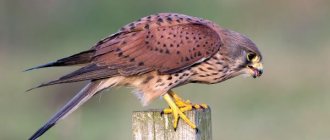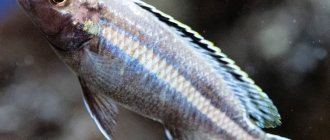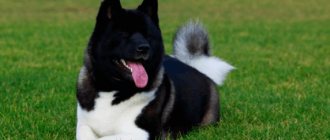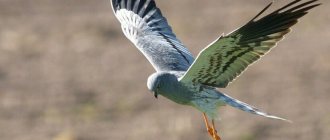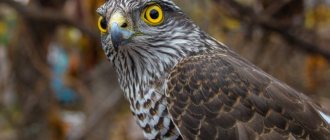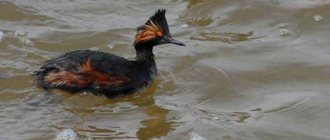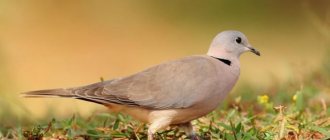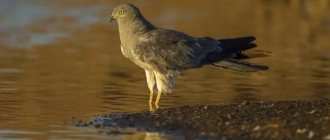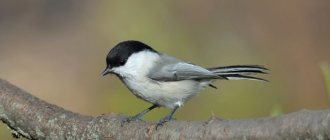| Latin name: | Falco tinnunculus |
| English name: | To be confirmed |
| Kingdom: | Animals |
| Type: | Chordata |
| Class: | Birds |
| Squad: | Falconiformes |
| Family: | Falcons |
| Genus: | To be confirmed |
| Body length: | 33-39 cm |
| Wing length: | 24-29 cm |
| Wingspan: | 65-81 cm |
| Weight: | 190—300 g |
Description of the bird
The kestrel is a small bird of prey with a long tail and wings. The length of its body is from 33 to 39 cm. The length of the wing is in the range of 24-29 cm. The wingspan is from 65 to 81 cm. Females are larger in size than males, their weight is from 190 to 300 g. The average weight of a male is about 160 g , the maximum reaches 260 g. Moreover, in males the body weight is always the same. And females reach their maximum size during the laying period. The heavier the bird is during this period, the larger its clutch and the better the offspring survive.
— Advertising —
The male has gray plumage on his head and tail. The remaining parts of the body are pale red. There are round black spots on the back. The flight feathers are almost black. At the end of the tail there is a wide black stripe with white edges. The neck is light.
The head and back of females are buffy-red in color, with transverse dark stripes. The flight feathers are dark brown. The tail is brown, with numerous dark stripes. At the end of the tail there is a wide dark stripe with a light border.
The plumage color of young birds is the same as that of females. But their wings are shorter and rounded.
Both males and females have yellow rings around their eyes. The cere and paw are bright yellow. The claws are black. The beak is dark gray.
Feeding features of the kestrel
— Advertising —
The basis of the kestrel's diet is voles, shrews and mice, as well as lizards, earthworms, insects, frogs, and bats. Of the birds, the kestrel preys on sparrows and pigeon chicks.
The kestrel hunts in different ways. She can sit motionless on hills and look out for her victims from there, or she hovers for a long time in the air at an altitude of 10 to 20 meters above the ground. Seeing the prey, the kestrel quickly rushes at it and kills it with a blow to the back of the head with its powerful beak. The bird eats 6 to 8 voles per day. The predator can hunt worms, shrews, lizards, and frogs on the surface of the ground, and small birds - in flight.
The kestrel is characterized by a so-called “quivering” flight. The bird freezes in place, flapping its wings frequently. The kestrel uses it in places where there are large concentrations of rodents.
Flight
Kestrels can fly in still air, even indoors in a barn. When hovering, they fly facing any slight headwind.
Most species of kestrels are well known for their spectacular fluttering flight. They use it to search for prey, hovering in place at a height of 10–20 m and looking for a suitable hunting object. The wing beats are very fast and frequent, the tail is fanned out and slightly lowered down. The wings move in one wide horizontal plane and simultaneously move large masses of air. Having noticed potential prey, for example, a vole, the kestrel dives down and grabs it, slowing down right at the ground. Gulls, terns, and small predators looking out for prey have the ability to flutter flight. In a similar way, hummingbirds sucking nectar “hang” in the air near a flower; in this case, the wing makes 50-80 beats per second. Trembling flight is also characteristic of some insects.
A quick flight around hunting grounds - route flight - is achieved with the help of rapid flapping of the wings. When the wind is favorable or in the process of eating prey, the kestrel can also glide.
Bird distribution
The kestrel's habitat covers Europe, western Asia and northern Africa. Some populations lead a sedentary lifestyle, others are migratory. Migrations mainly depend on the amount of food in the nesting areas. But usually from the northern regions of Europe and Asia there is a complete migration to the south of the European or African continent. Young animals make longer flights, and mature individuals remain close to their native places. From Russia for the winter, kestrels migrate to the east of the Mediterranean.
Common types of kestrel
Mauritian kestrel (Falco punctatus)
The species is endemic to the island of Mauritius, which at the end of the last century was on the verge of extinction, but was saved and now continues to restore its numbers.
Males and females are not sexually dimorphic, they are the same in size, and are ocher in color with dark streaks.
Madagascar kestrel (Falco newtoni)
A sedentary species that lives on the islands of Madagascar and Mayotte, as well as on Aldabra Atoll.
This is a small bird with a body length of about 30 cm and a weight of up to 120 g. The plumage is the same as that of the common kestrel.
Common kestrel (Falco tinnunculus)
The body length of males reaches 34.5 cm, females - 36 cm. The wingspan of males and females is about 75 cm. The weight of males is up to 200 g, in females it can reach 300 g.
Sexual dimorphism is expressed in plumage. The male's head is light gray, while the female's is brownish-brown. On the brown back of the male, small black spots, sometimes diamond-shaped, are noticeable. The male's upper tail coverts, loin and tail feathers are light gray. The end of the tail is decorated with distinct black stripes edged with white. The undertail is cream-colored with brown stripes or spots. The belly and wings below are almost white.
Adult females have a dark transverse band on the back, their tail is brown with many transverse stripes and a border at the end. The abdomen is dark and spotted.
Young birds look like females. But they are distinguished by short, rounded wings.
The cere and ocular ring are yellow in adults, and light blue to light green in chicks. The tail is rounded. The feet are dark yellow with black claws.
The species is distributed in Europe, Asia and Africa.
Gray-bearded or Australian kestrel (Falco cenchroides)
A small bird with a body length of 31 to 35 cm.
Lives in Australia, Christmas Island, New Guinea, New Zealand, New Caledonia.
Seychelles kestrel (Falco araea)
It breeds only in the Seychelles archipelago, does not migrate, and is the only bird of prey on these islands. The total population size does not exceed 1000 individuals. The species is endangered.
The body length of the Seychelles kestrel does not exceed 20 cm. The wingspan is from 40 to 45 cm. The bird's head is small, bluish-gray or black. The plumage on the back is brown, the wings and tail are decorated with black stripes. The beak is dark, the paws and wax are yellow. Young birds have lighter feathers with dark stripes.
Great kestrel (Falco rupicoloides)
The bird's body length is from 29 to 37 cm, its wingspan is 6884 cm, and its weight is in the range of 165-330 g.
The species nests in open areas of savannas, semi-deserts and deserts in eastern and southern Africa.
Fox kestrel (Falco alopex)
A large, slender bird with narrow long wings and a tail. Body length is 32-38 cm, wingspan is from 76 to 88 cm, body weight is from 250 to 300 g.
The species' habitat includes savannas south of the Sahara and Mali and east to Ethiopia and northwestern Kenya. The species leads a sedentary lifestyle and prefers to live in rocky areas. It is found at altitudes up to 2200 m above sea level. The total population of the fox kestrel does not exceed 100,000 pairs.
Steppe Kestrel (Falco naumanni)
A small graceful bird with narrow wings. Its body length is from 29 to 33 cm, its wingspan is 58-75 cm, the weight of males is from 90 to 180 g, females - from 135 to 210 g. Outwardly it resembles an ordinary kestrel, but differs from it in its small size, wing structure, and voice. The tail is long, wide, wedge-shaped. In flight, it often hovers in the air.
An adult male has a gray head, without whiskers. The shoulders, back and wing coverts are brick-red in color without a pattern. The rump and tail are gray, the end of the tail is decorated with a wide black stripe with a white border. The primaries are dark brown, almost black; The secondaries are grey. The wings are whitish below. The chest and belly are buffy, occasionally mottled.
The female is darker and mottled, rusty-red with dark longitudinal streaks along the top of the body, buffy or white below with sparse streaks. The flight feathers are black and brown
Young birds resemble females.
The claws are white. The iris is brown, the beak is yellow or orange with a black tip.
The species lives in northwestern Africa and Eurasia. Winters mainly in Africa south of the Sahara.
Passerine or American kestrel (Falco sparverius)
The body length of the female is from 23 to 30 cm, the wingspan is 57-61 cm, the weight does not exceed 120 g. The body length of males is 23-27 cm, the wingspan is from 51 to 56 cm, body weight is up to 110 g. The plumage of the male is bright, contrasting , combines black, light gray, red-red and white colors. The female's plumage is not so luxurious, and resembles a common kestrel.
The sparrow kestrel lives in North, Central and South America, on the Caribbean islands, from Canada to the Falkland Islands. In most of its range it leads a sedentary lifestyle.
The population size of this species is high and stable. In the USA, the bird is often used for falconry.
Range, habitats
Kestrels have scattered across almost the entire globe and are found in Europe, Asia, America, Africa and Australia. Birds easily adapt to different landscapes, mainly flat ones, avoiding both overly dense thickets and treeless steppes. The kestrel settles in open areas with low vegetation, where small game (object of bird hunting) is found in abundance. If the food supply is rich, birds quickly adapt to different altitudes. In the absence of trees, the kestrel nests on power poles and even on bare ground.
This is interesting! In Central Europe, birds inhabit not only coppice/edges, but also cultivated landscapes. The kestrel is not afraid to be near people and is increasingly found in the city, settling in residential areas or in ruins.
The steppe kestrel lives in steppes and semi-deserts, where it nests in mounds, rubble and ruined stone sheds. In the European part of Russia, it chooses for nesting ravines, ravines (with landslide cliffs) and river valleys, on the banks of which there are outcrops of parent rocks. In the mountains of Southern Siberia and the Southern Urals, birds gravitate to river valleys, the sides of ravines, the slopes of ridges, rocky outcrops of remnant mountains, ledges on plateau-like hills and ridges on the tops of hills.
Return to content
Male and female kestrel: main differences
The kestrel is characterized by sexual dimorphism, both in size and in the color of the plumage of males and females. Females are always larger in size than males. The plumage of the male has a bluish color on the head and tail, while the female is colored buffy-red, with transverse dark stripes. In addition, the male has dark round spots on his back.
Natural enemies
When breeding chicks in the forest, the kestrel (like other falcons) does not bother building a nest, occupying those left by magpies, crows and rooks. This trio of birds is considered the natural enemies of the kestrel, and not of adults, but of clutches and growing chicks.
Kestrel nests are also destroyed by martens and people. The latter for the sake of idle curiosity. About thirty years ago, kestrels were also caught at the sight of hunters, but now this rarely happens. But in Malta the kestrel was completely destroyed by shooting.
Return to content
Kestrel breeding
The kestrel nests in April-May in the northern habitat, and in August-December in the southern. The bird does not build its own nest. The kestrel occupies abandoned nests of other birds, or lays eggs directly on rocks, in tree hollows, in holes in the ground, and even in man-made structures.
Clutches are often located near songbird nests. Kestrels usually live in colonies of several dozen pairs of birds.
A kestrel's clutch contains from 3 to 6 eggs (minimum 2, maximum 8). The incubation period lasts 4 weeks. Both partners incubate the eggs. Newborn chicks are covered with white down, which turns grayish-white. Their claws and beak are also white. At the age of 1 month, the chicks begin to fly. But they continue to live with their parents for another month and learn to hunt.
Kestrels reach sexual maturity already in the first year of life. The average lifespan of a bird is 15 years. Maximum - up to 24 years.
Where is the nest?
The small falcon arrives from its winter habitats in mid-April - early May. The nest is built in pairs. Less often you can find several more pairs nearby or even a colony, but no more than 10 birds.
The common kestrel prefers to nest on not very open edges and even on power lines. Less commonly, its home can be found on small rocks or rivers, along steep banks. It is not involved in nest building, like most falcons, but finds unoccupied nests abandoned by magpies, rooks or crows. Sometimes a family of kestrels can be found in a hollow on a separate tree, and it does not matter that the hollow was not empty. The bird easily kicks out its owners and settles in on its own. The selected nest is symbolically completed with several branches.
Kestrel voice
Scientists recorded 11 different sound signals in female kestrels, and more than nine in males. All these sounds vary in volume, pitch and frequency, and are used by birds in different situations.
You can especially often hear the voice of a kestrel during the mating season, when females beg for food from males, and they look after them.
The sound of the kestrel's voice is described as "ti-ti-ti" or "ki-ki-ki", this signal indicates the bird's excitement, it can be heard if the kestrel is disturbed in the nest. The male also makes a similar call when he brings prey to the nest.
Interesting facts about the bird
- In East Slavic languages, two names for the bird are noted: “kestrel” in Russian, and “pustalga” in Belarusian. In Ukrainian the species is called “boriviter”. The origin of the word “kestrel” is associated with the word “empty”, since the bird is not suitable for falconry. According to another version, the name “kestrel” comes from the bird’s method of hunting in open spaces (pastures) and has the meaning “looking out.” The Ukrainian name is “boriviter” due to the fact that while soaring, the kestrel flies with its head towards the oncoming wind.
Notes
- Boehme R. L., Flint V. E.
Five-language dictionary of animal names. Birds. Latin, Russian, English, German, French / Under the general editorship of academician. V. E. Sokolova. - M.: Rus. lang., "RUSSO", 1994. - P. 50. - 2030 copies. — ISBN 5-200-00643-0. - ↑ 1 2 Galushin V.M., Drozdov N.N., Ilyichev V.D., Konstantinov V.M., Kurochkin E.N., Polozov S.A., Potapov R.L., Flint V.E., Fomin V. .E.
Fauna of the World: Birds: Directory. - M: Agropromizdat, 1991. - P. 8990. - 311 p. — ISBN 5-10-001229-3.
